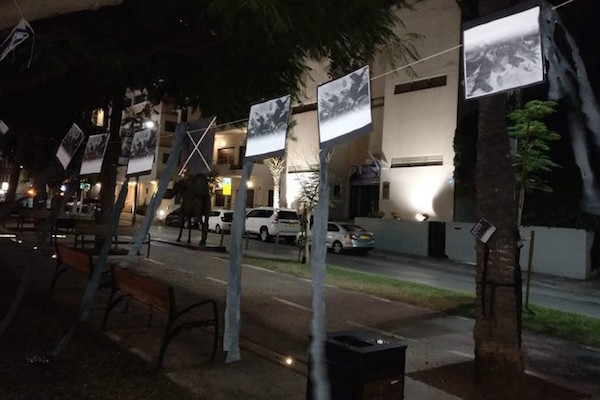In the middle of the night, left-wing activists hung 115 kites along Rothschild Boulevard, Tel Aviv’s central street — one for each Palestinian protester killed by Israeli forces during the Great Return March protests.

Israeli activists hung 115 black kites along Tel Aviv’s Rothschild Boulevard overnight on Sunday, in remembrance of every Palestinian killed by the Israeli army in Gaza during the Great Return March.
“We all witnessed what happened in Gaza over the past couple of weeks, says A., one of the organizers of the action. “There was a big escalation both in terms of what happened and the responses. We stood and watched how they opened fire on people who were demonstrating and, at the same time, the public’s indifference and the media’s coverage of the killing.”
The action was partially a response to the 60 Palestinians killed during the protests on May 14. A., who was abroad at the time, struggled to comprehend what had happened. “I returned to Israel and I was in shock to see that [here] nothing had happened — complete indifference.”
“There were, of course, actions by groups like the Coalition of Women for Peace and the solidarity protests in Haifa,” she added, “but I felt we needed to bring the faces of these 115 people who were killed, who have brothers and sisters and parents, to the Israeli public.”
“The kites were part of this, a follow-up to the pinning of the faces of those killed on the fence near Gaza,” A. said. “On Friday, kites with the names of those killed were flown. We took the next step and brought their faces to the heart of Rothschild, where one cannot smell the ash, and where it is easy to look away from the daily killing. We could not remain silent.”
In addition to the picture of the deceased, each kite bore their name in Arab and Hebrew, as well as their date of birth. “You see how young they were and you realize that we have been wardens guarding the prisoners in the world’s largest prison for three generations.”
The kites are also symbolic. Over the past few weeks, Palestinians have launched burning kites into Israeli towns on the border with Gaza, causing immense damage to local agriculture.
“People passed by, read, and looked at the names. Some ripped the kites and tore them down,” A. explained. “We gathered the names of those killed from all sorts of sites and read about the backgrounds of each one. It was unbearable.”
“A kite has no borders,” A. continued. “We are fighting groups of people launching kites? We need to explain to soldiers not to shoot people flying kites? Is a war really about to break out because of kites?”
I ask A. about what remained of the action the next morning. “Some are on the ground, the ones we hung higher are still on the trees. Some were soaked by the sprinklers and left their mark on the trees, like a signature.”
“We wanted to break the quiet in our neighborhood,” A. concludes. “To tell the indifferent Israeli public that we will not have peace and quiet until they [the Palestinians] do. And that’s before we talk about our stained morality — and about the blood.”
This article was first published in Hebrew on Local Call. Read it here.

